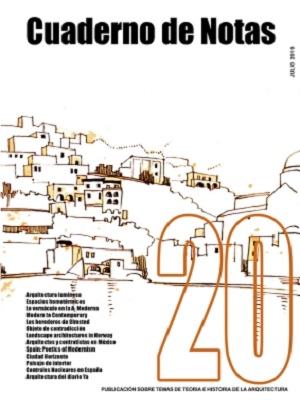Espacios homotérmicos: una historia de la calefacción central en la arquitectura del siglo XIX
DOI:
https://doi.org/10.20868/cn.2019.4246Palabras clave:
Arquitectura, calefacción centralizada, diseño ambiental, heterotermia, homotermia, architecture, central heating, environmental design, heterothermia, homothermiaResumen
Resumen
Propiciada por la Revolución Industrial, la irrupción de los nuevos sistemas de calefacción centralizada en sus diferentes variantes (aire, vapor o agua) dio pie a una verdadera revolución en la arquitectura: el paso desde la heterotermia (el espacio organizado en gradiente en torno a un único foco térmico) hasta la homotermia (el espacio isótropo servido por focos térmicos repartidos). Este artículo da cuenta de esta revolución a través de tres análisis complementarios: el análisis de los orígenes de los sistemas de calefacción centralizado; el de las crisis técnicas, sociales y simbólicas que produjo la implantación de dichos sistemas en los espacios del siglo XIX; y, finalmente, el de las estrategias que utilizaron los arquitectos de la época para integrar la nueva maquinaria.
Abstract
Brought on by the Industrial Revolution, the breakthrough of centralized heating in its different versions (air, steam, or water) gave rise to a genuine revolution in architecture: the passage from heterothermia (space organized in a gradient around a single thermal focus) to homothermia (the isotropic space served by split thermal foci). This article discusses that revolution through three complementary analyses: of the origins of centralized heating systems; of the technical, social, and symbolic crises produced by the implantation of those systems in 19th-century spaces; and of the strategies that architects of the period used to accommodate the new machinery.
Descargas
Referencias
Banham, Reyner. 1969. The Architecture of Well-tempered Environment, Londres: Architectural Press, 1969 [edición en español: La arquitectura del entorno bien climatizado, Buenos Aires: Ediciones Infinito, 1975].
Bernan, Walter. 1845. On the History and Art of Warming and Ventilating Rooms and Buildings, vol. 1, Londres: George Bell.
Bernan, Walter. 1845. On the History and Art of Warming and Ventilating Rooms and Buildings, vol. 2, Londres: George Bell.
Bruegmann, Robert. 1978. “Central Heating and Forced Ventilation: Origins and Effects on Architectural Design”, Journal of the Society of Architectural Historians, vol. 37, nº 3 (octubre 1978).
Buchanan, Robertson. 1807. An Essay of the Warming of Mills and Other Buildings by Steam, Glasgow.
Carpenter, Rolla. 1900. Heating and Ventilating Buildings: A Manual for Heating Engineers and Architects, Nueva York: John Wiley and Sons.
Chabannes, Jean-Baptiste de. 1818. On conducting air by forced ventilation and regulating the temperatures in dwellings, with a description of the application of the principles as established in Covent Garden Theatre and Lloyd’s Subscription Rooms, Londres.
Chabannes, Jean-Baptiste de. 1820. Appendix to the Marquis de Chabannes’ publication of Conducting air by forces ventilation and equalizing the temperature of dwellings, Londres.
Evans, Oliver. 1795. The Young Mill-Wright & Miller’s Guide, Filadelfia.
Forster, Shirley. 1883. Our Homes and How to Make Healthy, Londres: Cassell & Company.
Giedion, Sigfried. 1948. Mechanization Takes Command: A Contribution to Anonymous History, Nueva York: Oxford University Press.
Hood, Charles. 1837. A Practical Treatise of Warming Buildings by Hot Water, Londres: Whittaker & Co.
International Health Exhibition London 1884. The Health Exhibition Literature. Vol. 1: Health in the Dwelling, Londres: William Clowes and sons.
Joly, V. Ch. 1873. Traité pratique du chauffage, de la ventilation et de la distribution des eaux dans les habitations particulières, París: J. Baudry.
Peterson, Charles E. 1976. Building Early America: Contributions toward the History of a Great Industry, Rednor: Chilton Book Company.
Prieto, Eduardo. 2016. La ley del reloj: arquitectura, máquinas y cultura moderna, Madrid: Ediciones Cátedra.
Richardson, Charles J. 1839. A Popular Treatise on the Warming and Ventilation of Buildings; showed the advantages of the improved system of heated water circulation, Londres: John Weale, architectural library.
Rybcynski, Witold, 2007. La casa: historia de una idea, San Sebastián: Nerea [primera edición en inglés: The Home: A Short History of an Idea, Londres: Penguin Books, 1987].
Sylvester, Charles. 1819. The Philosophy of Domestic Economy; as exemplified in the mode of warming, ventilating, washing, drying, & cooking, and in Various Arrangements contributing to the Comfort and Convenience of Domestic Life, adopted in The Derbyshire General Infirmay, and more recently, on a greatly extended scale, in several other public buildings, newly erected in this country, Londres: H. Barnett, High Strett.
Tann, Jennifer. 1970. The Development of the Industry, Londres: Conmarket Press.
Thoreau, Henry D. 2005. Walden, Madrid: Cátedra.
Transactions of the Society of Arts, 1806 (150-162).
Tredgold, Thomas. 1824. Principles of Warming and Ventilating Public Buildings, Dwelling Houses, Manufactories, Hospitals, Hot Houses, Conservatories, etc. Londres.
Wright, Lawrence. Home Fires Burning: The History of Domestic Heating and Cooking, Londres: Routledge & Kegan Paul, 1964.













